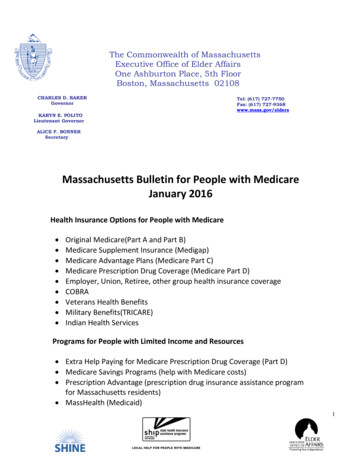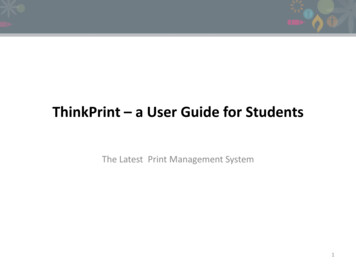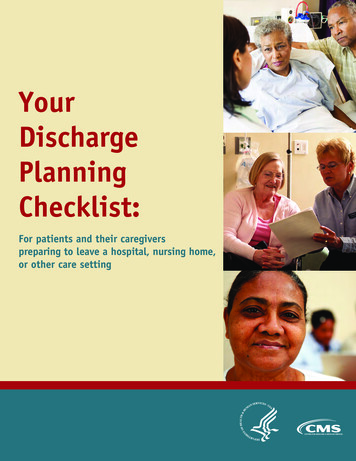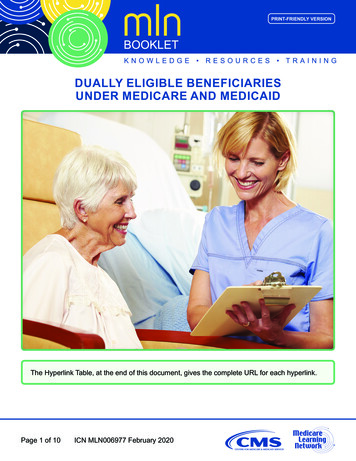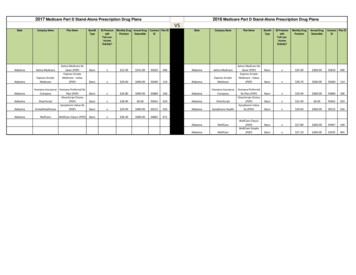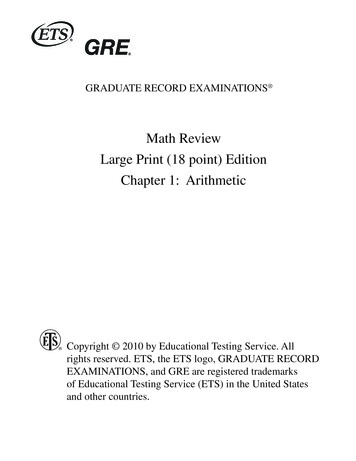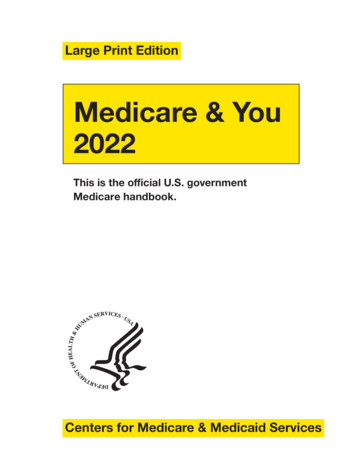
Transcription
Large Print EditionMedicare & You2022This is the official U.S. governmentMedicare handbook.Centers for Medicare & Medicaid Services
2 What’s new & important?What’s new & important?COVID-19-related tests, items, & servicesMedicare covers several tests, items, and services relatedto coronavirus disease 2019 (COVID-19), like vaccines,diagnostic tests, antibody tests, and monoclonal antibodytreatments. See page 78.Cognitive assessment & care plan servicesMedicare covers a cognitive assessment to help detectthe earliest signs of cognitive impairment. Your doctormay perform this assessment during a routine visit. If youshow signs of cognitive impairment, Medicare also coversa separate visit with your regular doctor or specialist to doa full review of your cognitive function, establish or confirma diagnosis like dementia, including Alzheimer’s disease,and develop a care plan. See page 72.Blood-based biomarker testMedicare covers this screening test for colorectal cancer,in certain cases, once every 3 years. See page 76.
3 What’s new & important?Medicare.gov updatesWe’re making updates to Medicare.gov throughout theyear to improve your online experience. We’re focused onmaking it easier to find and use the information you need.Help in accessible formats and additionallanguagesYou can get the “Medicare & You” handbook in anaccessible format at no cost to you. See page 264.To get free help in a language other than English, seepages 320 – 322.
4 ContentsContentsWhat’s new & important? 2What are the parts of Medicare? 6Your Medicare options 8At a glance: Original Medicare vs. MedicareAdvantage 10Get started with Medicare 16Get the most out of Medicare 18Section 1: Signing up for Medicare 21Section 2: Find out if Medicare covers your test, item,or service 45Medicare & COVID-19 78Section 3: Original Medicare 133Section 4: Medicare Advantage Plans & otheroptions 143Section 5: Medicare Supplement Insurance(Medigap) 177
5 ContentsSection 6: Medicare drug coverage (Part D) 189Section 7: Get help paying your health & drugcosts 221Section 8: Know your rights & protect yourself fromfraud 237Section 9: Get more information 267Section 10: Definitions 293Index of topics 302Help in other languages 320Can’t find what you’re looking for?Check the “Index of topics” starting on page 302.
6 What are the parts of Medicare?What are the parts of Medicare?Part A (Hospital Insurance)Helps cover:Inpatient care in hospitals Skilled nursing facility careHospice careHome health careSee pages 45 – 55.Part B (Medical Insurance)Helps cover:Services from doctors and other health care providers Outpatient careHome health careDurable medical equipment (like wheelchairs, walkers,hospital beds, and other equipment)Many preventive services (like screenings, shots orvaccines, and yearly “Wellness” visits)See pages 56 – 127.
7 What are the parts of Medicare?Part D (Drug coverage)Helps cover the cost of prescription drugs (including manyrecommended shots or vaccines).Plans that offer Medicare drug coverage (Part D) are runby private insurance companies that follow rules set byMedicare.See pages 189 – 220.Replace your Medicare cardIf you need to replace your Medicare card becauseit’s damaged or lost, log into (or create) your secureMedicare account at Medicare.gov to print or order anofficial copy of your Medicare card. You can also call1 800 633 - 4227 and ask for a replacement card to besent in the mail. TTY users can call 1 877 486 - 2048.
8 Your Medicare optionsYour Medicare optionsWhen you first enroll in Medicare and during certain timesof the year, you can choose how you get your Medicarecoverage. There are 2 main ways to get Medicare:Original Medicare Original Medicare includes Medicare Part A (HospitalInsurance) and Part B (Medical Insurance).You can join a separate Medicare drug plan to getMedicare drug coverage (Part D).You can use any doctor or hospital that takesMedicare, anywhere in the U.S.To help pay your out-of-pocket costs in OriginalMedicare (like your 20% coinsurance), you canalso shop for and buy supplemental coverage. Thisincludes Medicare Supplement Insurance (Medigap).See Section 5 (starting on page 177) to learn moreabout Medigap. Or, you can use coverage from aformer employer or union, or Medicaid.See Section 3 (starting on page 133) to learn moreabout Original Medicare.
9 Your Medicare optionsMedicare Advantage (also known as Part C) Medicare Advantage is a Medicare-approved planfrom a private company that offers an alternative toOriginal Medicare for your health and drug coverage.These “bundled” plans include Part A, Part B, andusually Part D.In most cases, you’ll need to use doctors who are inthe plan’s network.Plans may have lower out-of-pocket costs thanOriginal Medicare.Plans may offer some extra benefits that OriginalMedicare doesn’t cover—like vision, hearing, anddental services.See Section 4 (starting on page 143) to learn moreabout Medicare Advantage.
10 At a glance: Medicare vs. Medicare AdvantageAt a glance: Original Medicare vs.Medicare AdvantageDoctor & hospital choiceOriginal Medicare You can go to any doctor or hospital that takesMedicare, anywhere in the U.S.In most cases, you don’t need a referral to see aspecialist.Medicare Advantage (Part C) In many cases, you’ll need to only use doctors andother providers who are in the plan’s network(for non-emergency care). Some plans offernon-emergency coverage out of network, but typicallyat a higher cost.You may need to get a referral to see a specialist.
11 At a glance: Medicare vs. Medicare AdvantageCostOriginal Medicare For Part B-covered services, you usually pay 20% ofthe Medicare-approved amount after you meet yourdeductible. This is called your coinsurance.You pay a premium (monthly payment) for Part B.If you choose to join a Medicare drug plan, you’ll paya separate premium for your Medicare drug coverage(Part D).There’s no yearly limit on what you pay out ofpocket, unless you have supplemental coverage—likeMedicare Supplement Insurance (Medigap).You can get Medigap to help pay your remainingout-of-pocket costs (like your 20% coinsurance). Or,you can use coverage from a former employer orunion, or Medicaid.
12 At a glance: Medicare vs. Medicare AdvantageMedicare Advantage (Part C) Out-of-pocket costs vary—plans may have differentout-of-pocket costs for certain services.You pay the monthly Part B premium and may alsohave to pay the plan’s premium. Plans may have a 0premium and may help pay all or part of your Part Bpremium. Most plans include Medicare drug coverage(Part D).Plans have a yearly limit on what you pay out ofpocket for services Medicare Part A and Part B covers.Once you reach your plan’s limit, you’ll pay nothing forservices Part A and Part B covers for the rest of theyear.You can’t buy and don’t need Medigap.CoverageOriginal Medicare Original Medicare covers most medically necessaryservices and supplies in hospitals, doctors’ offices,and other health care facilities. Original Medicaredoesn’t cover some benefits like eye exams, mostdental care, and routine exams. See page 127.
13 At a glance: Medicare vs. Medicare Advantage You can join a separate Medicare drug plan to getMedicare drug coverage (Part D).In most cases, you don’t have to get a service orsupply approved ahead of time for Original Medicare tocover it.Medicare Advantage (Part C) Plans must cover all of the medically necessaryservices that Original Medicare covers. Most plansoffer some extra benefits that Original Medicaredoesn’t cover—like some routine exams and vision,hearing, and dental services.Medicare drug coverage (Part D) is included inmost plans. In most types of Medicare AdvantagePlans, you can’t join a separate Medicare drug plan.In some cases, you have to get a service or supplyapproved ahead of time for the plan to cover it.
14 At a glance: Medicare vs. Medicare AdvantageForeign travelOriginal Medicare Original Medicare generally doesn’t cover careoutside the U.S. You may be able to buy a MedicareSupplement Insurance (Medigap) policy that coversemergency care outside the U.S.Medicare Advantage (Part C) Plans generally don’t cover care outside the U.S.Some plans may offer a supplemental benefit thatcovers emergency and urgently needed services whentraveling outside the U.S.End of Page
15 At a glance: Medicare vs. Medicare AdvantageThis book explains these topics in more detail: Original Medicare: See Section 3 (starting onpage 133).Medicare Advantage: See Section 4 (starting onpage 143).Medicare Supplement Insurance (Medigap): SeeSection 5 (starting on page 177).Medicare drug coverage (Part D): See Section 6(starting on page 189).End of Page
16 Get started with MedicareGet started with MedicareIf you’re new to Medicare or already haveexperience with Medicare, it’s important foryou to: Understand your Medicare coverage options. Thereare 2 main ways to get your Medicare coverage—Original Medicare (Part A and Part B) and MedicareAdvantage. See pages 8 – 16 to learn more.Find out how and when you can enroll. If youdon’t have Medicare Part A or Part B, see Section 1(starting on page 21). If you don’t have Medicare drugcoverage (Part D), see Section 6 (starting on page 189).There may be penalties if you don’t enroll when you’refirst eligible. If you have other health insurance, seepages 30 – 38 to find out how your other insuranceworks with Medicare.Mark your calendar with these important dates!This may be the only chance you have each year tochange your coverage. October 1, 2021: Start comparing your currentcoverage with other options. You may beable to save money or get extra benefits. VisitMedicare.gov/plan-compare.
17 Get started with Medicare October 15 to December 7, 2021: Change yourMedicare health or drug coverage for 2022,if you decide to. You can join, switch or leave aMedicare Advantage Plan or a Medicare drugplan during this Open Enrollment Period each year.January 1, 2022: New coverage begins if youmade a change. If you kept your existing coverageand your plan’s costs or benefits changed, thosechanges also start on this date.January 1 to March 31, 2022: If you’re in aMedicare Advantage Plan, you can change toa different Medicare Advantage Plan or switch toOriginal Medicare (and join a separate Medicaredrug plan) once during this time. Any changes youmake will be effective the first of the month afterthe plan gets your request. See page 149.Each year, it’s important to review your Medicarehealth and drug coverage and make changes if itno longer meets your needs, or see if you could loweryour out-of-pocket costs. You don’t need to enroll inMedicare each year, but you should still review youroptions.See pages 8 – 20 for an overview of your Medicareoptions.
18 Get the most out of MedicareGet the most out of MedicareGet help choosing the coverage optionthat’s right for you Get free, personalized counseling from your StateHealth Insurance Assistance Program (SHIP)—Seepages 287 – 292 for the phone number. A trustedagent or broker may also be able to help.Call 1 800 633 - 4227. TTY users can call1 877 486 - 2048.Find and compare health and drug plans atMedicare.gov/plan-compare.Get the most value out of your health careWe want to make sure you have the information you needto make the best decisions about your health care. Thisincludes giving you access to accurate cost estimatesand quality information up front, so you can compare andchoose the providers and services that give you the mostvalue.Get free help with your Medicare questionsFor general Medicare questions, visit Medicare.gov orcall 1 800 633 - 4227. See pages 267 – 286 to learn aboutother resources.
19 Get the most out of MedicareGet preventive servicesMedicare covers many preventive services at no costto you. Ask your doctor or other health care providerwhich preventive services (like screenings, shots orvaccines, and yearly “Wellness” visits) you need. Seepages 58 – 127 to learn more about which preventiveservices Medicare covers.Get help paying for health careThere are multiple programs available to help with costs.Many people with Medicare qualify. For information onthese programs, see pages 221 – 236.Get mental health & substance use disorderservicesMedicare covers certain screenings, services, andprograms that aid in the treatment and recovery of mentalhealth and substance use disorders: Alcohol misuse screening: See page 61.Behavioral health integration services (to manageconditions like depression or anxiety): See page 64.Counseling to prevent tobacco use &tobacco-caused disease: See page 77.Depression screening: See page 81.
20 Get the most out of Medicare Mental health care: See page 103.Opioid use disorder treatment services: Seepage 106.Reviews with your provider, if you have aprescription for opioids: See page 124.Telehealth: See page 115.Medication (coverage rules): See page 207.Prescription safety checks: See page 208.Drug management programs: See page 208.Important tips if you’re prescribed opioids: Seepage 210.Get the handbook onlineHelp save tax dollars by switching to the electronicversion of this handbook. Log into (or create) your secureMedicare account online at Medicare.gov to switchto the electronic handbook. We’ll email you a link to aPDF version instead of sending a paper copy in the maileach fall.
21Section 1: Signingup for MedicareWill I get Part A and Part B automatically?If you’re already getting benefits from Social Securityor the Railroad Retirement Board (RRB), you’llautomatically get Part A and Part B starting the first day ofthe month you turn 65. (If your birthday is on the first dayof the month, Part A and Part B will start the first day ofthe prior month.)If you’re under 65 and have a disability, you’llautomatically get Part A and Part B after you get disabilitybenefits from Social Security or certain disability benefitsfrom the RRB for 24 months.If you live in Puerto Rico, you don’t automatically getPart B. You must sign up for it. See page 24.If you have ALS (amyotrophic lateral sclerosis, alsocalled Lou Gehrig’s disease), you’ll get Part A andPart B automatically the month your Social Securitydisability benefits begin.Underlined words are defined on pages 293 – 301.
22 Section 1: Signing up for MedicareIf you’re automatically enrolled, you’ll get your red,white, and blue Medicare card in the mail 3 monthsbefore your 65th birthday or 25th month of disabilitybenefits, and you don’t need to pay a premium forPart A (sometimes called “premium-free Part A”). Mostpeople choose to keep Part B. If you don’t want Part B, letus know before the coverage start date on your Medicarecard. If you do nothing, you’ll keep Part B and will haveto pay Part B premiums through your Social Securitybenefits. If you choose not to keep Part B but decideyou want it later, you may have to wait to enroll andpay a penalty for as long as you have Part B. Seepage 39.If you need to get a replacement Medicare cardbecause it’s damaged or lost, log into (or create)your secure Medicare account at Medicare.govto print or order an official copy of your Medicarecard. You can also use this account to manage yourpersonal and other coverage information (like yourdrug list and claims status). See page 271 for moreinformation about Medicare.gov. You can also call1 800 633 - 4227 to get a replacement card. TTY userscan call 1 877 486 - 2048. If you need to replace yourcard because you think that someone else is using yourMedicare Number, call 1 800 633 - 4227.
23 Section 1: Signing up for MedicareWill I have to enroll in Part A and/or Part B?If you’re close to 65, but NOT getting SocialSecurity or Railroad Retirement Board (RRB)benefits, you’ll need to enroll in Medicare. Visitsocialsecurity.gov/benefits/medicare to apply forPart A and Part B. You can also contact Social Security3 months before you turn 65 to set up an appointment. Ifyou worked for a railroad, contact the RRB.In most cases, if you don’t sign up for Part B when you’refirst eligible, you may have a delay in getting MedicarePart B coverage in the future (in some cases over a year),and you may have to pay a late enrollment penalty foras long as you have Part B. See page 39.If you have End-Stage Renal Disease (ESRD) andyou want Medicare, you’ll need to enroll. ContactSocial Security to find out when and how to enrollin Part A and Part B. For more information, visitMedicare.gov/publications to view the booklet,“Medicare Coverage of Kidney Dialysis & KidneyTransplant Services.”
24 Section 1: Signing up for MedicareImportant!If you live in Puerto Rico and get benefits from SocialSecurity or the RRB, you’ll automatically get Part A thefirst day of the month you turn 65 or after you get disabilitybenefits for 24 months. However, if you want Part B, you’llneed to sign up for it by completing an “Application forEnrollment in Part B Form” (CMS-40B). rmsto get Form CMS-40B in English or Spanish. If you don’tsign up for Part B when you’re first eligible, you may haveto pay a late enrollment penalty for as long as youhave Part B. See page 39.Where can I get more information?Call Social Security at 1 800 772 - 1213 for moreinformation about your Medicare eligibility and to enroll inPart A and/or Part B. TTY users can call 1 800 325 - 0778.If you worked for a railroad or get RRB benefits, callthe RRB at 1 877 772 - 5772. TTY users can call1 312 751 - 4701.You can also get free, personalized health insurancecounseling from your State Health Insurance AssistanceProgram (SHIP). See pages 287 – 292 for the phonenumber.
25 Section 1: Signing up for MedicareOnce you’re enrolled in Medicare, it’s time to lookat your coverage options. People get coverage indifferent ways. To get the most out of your coverage,review all of your Medicare coverage options and findwhat best meets your needs. See pages 10 – 17 formore information.If I didn’t get enrolled in Part A and Part Bautomatically, when can I enroll?If you didn’t get automatically enrolled in premium-freePart A (for example, because you’re still working andnot yet getting Social Security or Railroad RetirementBoard (RRB) benefits), you can sign up for premium-freePart A (if you’re eligible) any time during or after yourInitial Enrollment Period begins. See page 37 for moreinformation.If you’re eligible for premium-free Part A, you can enroll inPart A any time after you’re first eligible for Medicare. YourPart A coverage will go back (retroactively) 6 months fromwhen you enroll, but no earlier than the first month you’reeligible for Medicare. You can only sign up for Part Bduring the periods listed below.
26 Section 1: Signing up for MedicareImportant!Remember, in most cases, if you don’t enroll inPart A (if you have to buy it) and Part B when you’refirst eligible, your enrollment may be delayed andyou may have to pay a late enrollment penalty. Seepages 37 – 40.What are the Part A and Part B enrollmentperiods?You can only enroll in Part B (and/or Part A if you have tobuy it) during these enrollment periods.Initial Enrollment PeriodYou can first sign up for Part A and/or Part B during the7-month period that begins 3 months before the monthyou turn 65, includes the month you turn 65, and ends 3months after the month you turn 65.If you enroll in Part A and/or Part B during the first 3months of your Initial Enrollment Period, in most cases,your coverage begins the first day of your birthday month.However, if your birthday is on the first day of the month,your coverage will start the first day of the prior month.
27 Section 1: Signing up for MedicareIf you enroll in and are paying for Part A and/or Part Bthe month you turn 65 or during the last 3 months of yourInitial Enrollment Period, the start date for your Part Bcoverage will be delayed.Special Enrollment PeriodAfter your Initial Enrollment Period is over, you mayhave a chance to enroll in Medicare during a SpecialEnrollment Period. If you didn’t sign up for Part B (orPart A if you have to buy it) when you were first eligiblebecause you have group health plan coverage based oncurrent employment (your own, a spouse’s, or a familymember’s—if you have a disability), you can enroll inPart A and/or Part B: Anytime you’re still covered by the group health planDuring the 8-month period that begins the month afterthe employment ends or the coverage ends, whicheverhappens firstUsually, you don’t pay a late enrollment penalty if yousign up during a Special Enrollment Period. This perioddoesn’t apply if you’re eligible for Medicare based on EndStage Renal Disease (ESRD), or you’re still in your InitialEnrollment Period.
28 Section 1: Signing up for MedicareNote: If you have a disability, and the group healthplan coverage is based on a family member’s currentemployment (other than a spouse), the employer offeringthe group health plan must have 100 or more employeesfor you to get a Special Enrollment Period.Important!COBRA (Consolidated Omnibus Budget ReconciliationAct) coverage, retiree health plans, VA coverage, andindividual health insurance coverage (like coveragethrough the Health Insurance Marketplace ) aren’tconsidered coverage based on current employment.There may be reasons why you should take Part B insteadof, or in addition to, COBRA coverage. You aren’t eligiblefor a Special Enrollment Period to sign up for Medicarewhen that COBRA coverage ends. To avoid paying ahigher premium, make sure you enroll in Medicare whenyou’re first eligible. Your current coverage may not pay forhealth services you get if you don’t have both Part A andPart B. See page 215 for more information about COBRAcoverage.
29 Section 1: Signing up for MedicareGeneral Enrollment PeriodIf you have to pay for Part A but don’t sign up for it and/or don’t sign up for Part B (for which you must paypremiums) during your Initial Enrollment Period, and youdon’t qualify for a Special Enrollment Period, you cansign up during the General Enrollment Period betweenJanuary 1 – March 31 each year. Your coverage won’tstart until July 1 of that year, and you may have topay a higher Part A and/or Part B premium for lateenrollment. See pages 37 – 40.If you aren’t sure if you qualify for a Special EnrollmentPeriod, or to learn more about enrollment periods, visitMedicare.gov or call 1 800 633 - 4227. TTY users can call1 877 486 - 2048.
30 Section 1: Signing up for MedicareI have other coverage. Should I get Part B?This information can help you decide if you should getPart B based on the type of health coverage you mayhave.Employer or union coverageIf you or your spouse (or family member if you have adisability) are still working and you have health coveragethrough that employer or union, contact the employer orunion benefits administrator to find out how your coverageworks with Medicare (see page 34). This includes federalor state employment and active-duty military service. Itmight be to your advantage to delay Part B enrollmentwhile you still have health coverage based on your or yourspouse’s current employment.Coverage based on current employment doesn’tinclude: COBRARetiree coverageVA coverageIndividual health insurance coverage (like through theHealth Insurance Marketplace )
31 Section 1: Signing up for MedicareTRICAREIf you have TRICARE (health care program for active-dutyand retired service members and their families), yougenerally must enroll in Part A and Part B when you’refirst eligible to keep your TRICARE coverage. However,if you’re an active-duty service member or an active-dutyfamily member, you don’t have to enroll in Part B to keepyour TRICARE coverage. For more information, contactTRICARE. See page 219.If you have CHAMPVA coverage, you must enroll inPart A and Part B to keep it. Call 1 800 733 - 8387 formore information about CHAMPVA.MedicaidIf you have Medicaid and don’t have Part B, Medicaidmay help you enroll. Medicare will pay first, and Medicaidwill pay second. Medicaid may be able to help payyour Medicare out-of-pocket costs (like premiums,deductibles, coinsurance, and copayments).Call your State Medical Assistance (Medicaid) officefor more information and to see if you qualify. VisitMedicare.gov/talk-to-someone, or call 1 800 633 - 4227to get the phone number for your state’s Medicaid office.TTY users can call 1 877 486 - 2048.
32 Section 1: Signing up for MedicareHealth Insurance Marketplace Even if you have Marketplace coverage, you shouldgenerally enroll in Medicare when you’re first eligible toavoid the risk of a delay in Medicare coverage and thepossibility of a Medicare late enrollment penalty.Here are some important points to consider if you haveMarketplace coverage: You need to end your Marketplace coverage in a timelymanner to avoid an overlap in coverage.Once you’re considered eligible for or enrolled inPart A, you won’t qualify for help from the Marketplaceto pay your Marketplace plan premiums or othermedical costs. If you continue to get help payingfor your Marketplace plan premiums after you haveMedicare, you may have to pay back some or all of thehelp you got when you file your federal income taxes.Visit HealthCare.gov to connect to the Marketplacein your state and learn more. To find out how to endyour Marketplace plan or Marketplace savings whenyour Medicare coverage begins, visit to-medicare.You can also call the Marketplace Call Center at1 800 318 - 2596. TTY users can call 1 855 889 - 4325.
33 Section 1: Signing up for MedicareHealth Savings Account (HSA)You aren’t eligible to make contributions to an HSA afteryou have Medicare. To avoid a tax penalty, you shouldmake your last HSA contribution the month before yourPart A coverage begins. Premium-free Part A coveragebegins 6 months before the month you apply forMedicare, Social Security, or Railroad Retirement Board(RRB) benefits, but no earlier than the month you turn 65. If you apply for Medicare during your Initial EnrollmentPeriod or during the 2 months after your InitialEnrollment Period ends, you should make your lastHSA contribution the month before you turn 65.If you wait to enroll in Medicare less than 6 monthsafter you turn 65, you can avoid a tax penalty bystopping HSA contributions the month before youturn 65.If you wait to enroll in Medicare 6 or more months afteryou turn 65, you can avoid a tax penalty by stoppingHSA contributions 6 months before the month youapply for Medicare.Note: A Medicare Medical Savings Account (MSA) plan issimilar to an HSA plan. See page 158.For information on the Part B late enrollment penalty, seepage 39.
34 Section 1: Signing up for MedicareHow does my other insurance work withMedicare?When you have other insurance (like group health plan,retiree health, or Medicaid coverage) and Medicare, thereare rules for whether Medicare or your other coveragepays first. If you have retiree health coverage (like insurance fromyour or your spouse’s former employment) Medicarepays first.If you’re 65 or older, have group health plan coveragebased on your or your spouse’s current employment,and the employer has 20 or more employees Yourgroup health plan pays first.If you’re 65 or older, have group health plan coveragebased on your or your spouse’s current employment,and the employer has fewer than 20 employees Medicare pays first.If you’re under 65 and have a disability, have grouphealth plan coverage based on your or a familymember’s current employment, and the employer has100 or more employees Your group health planpays first.
35 Section 1: Signing up for Medicare If you’re under 65 and have a disability, have grouphealth plan coverage based on your or a familymember’s current employment, and the employer hasfewer than 100 employees Medicare pays first.If you have group health plan coverage based onyour or a family member’s employment or formeremployment, and you’re eligible for Medicare becauseof End-Stage Renal Disease (ESRD) Your grouphealth plan pays first for the first 30 months after youbecome eligible to enroll in Medicare. Medicare paysfirst after this 30-month period.If you have Medicaid. Medicare pays first.Important!If you’re still working and have employer coveragethrough work, contact your employer to find out how youremployer’s coverage works with Medicare.Here are some important facts to remember about howother insurance works with Medicare-covered services: The insurance that pays first (primary payer) pays up tothe limits of its coverage.The insurance that pays second (secondary payer) onlypays if there are costs the primary payer didn’t cover.
36 Section 1: Signing up for Medicare The secondary payer (which may be Medicare) mightnot pay all of the uncovered costs.If your group health plan or retiree health coverage isthe secondary payer, you might need to enroll in Part Bbefore your insurance will pay.Visit Medicare.gov/publications to view the booklet,“Medicare and Other Health Benefits: Your Guide to WhoPays First.” You can also call 1 800 633 - 4227 for moreinformation. TTY users can call 1 877 486 - 2048.Important!If you have other insurance or changes to yourinsurance, you need to let Medicare know by callingMedicare’s Benefits Coordination & Recovery Center at1 855 798 - 2627. TTY users can call 1 855 797 - 2627.If you have Part A, you may get a “Health Coverage” form(IRS Form 1095-B) from Medicare. This form verifies thatyou had health coverage in the past year. Keep the formfor your records. Not everyone will get this form. If youdon’t get Form 1095-B, don’t worry, you don’t need tohave it to file your taxes.
37 Section 1: Signing up for MedicareHow much does Part A coverage cost?You usually don’t pay a monthly premium for Part Acoverage if you or your spouse pai
This book explains these topics in more detail: Original Medicare: See Section 3 (starting on page 133). Medicare Advantage: See Section 4 (starting on page 143). Medicare Supplement Insurance (Medigap): See Section 5 (starting on page 177). Medicare drug coverage (Part D): See Section 6 (starting on page 189). End of Page .
